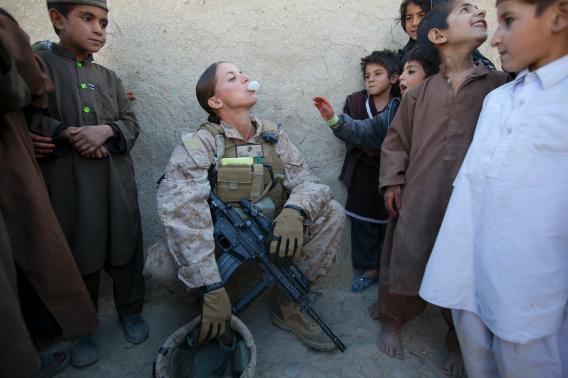 Sargent Sheena Adams, 25, US Marine with the FET (Female Engagement Team) 1st Battalion 8th Marines, Regimental Combat team II blows bubbles with Afghan boys surrounding her while on patrol on November 21, 2010 in Musa Qala, Afghanistan.
Sargent Sheena Adams, 25, US Marine with the FET (Female Engagement Team) 1st Battalion 8th Marines, Regimental Combat team II blows bubbles with Afghan boys surrounding her while on patrol on November 21, 2010 in Musa Qala, Afghanistan. Photo by Paula Bronstein/Getty Images
Should women be allowed in combat? The Pentagon says yes, but Jerry Boykin knows better. Boykin, a former Army lieutenant general, is the executive vice president of the Family Research Council. Since last week, when the military announced its decision to rescind the combat ban, Boykin has become the point man for opponents of the decision. It isn?t easy in 2013 to make the case that every man should be eligible for the draft but that no woman should be permitted to compete for a combat role in much of the armed forces. Is Boykin man enough for the job? Let?s see how he?s doing.
1. Women are too weak. ?We have seen in Iraq and Afghanistan that ground combat still requires levels of sheer physical strength, speed, and endurance that are relatively rare among women,? Boykin wrote in a USA Today op-ed on Thursday. A day later, in a commentary on CNN, he added,
The slots that may be opened are in our infantry and Special Forces units. The purpose of such units is to directly and physically engage enemy forces. This can often involve personal, hand-to-hand combat in which women will now have to fight men. These units can often be deployed in prolonged operations that can last for months. The physical toll is constant and wearing.
When Boykin talks about hand-to-hand combat and women fighting men, he seems to be suggesting that women can?t or won?t fight men effectively. But if combat-level physical abilities are ?relatively rare? among women, rather than nonexistent, doesn?t that undermine the idea of a categorical ban on women in combat? So Boykin turns to other arguments.
2. Combat missions are too gross for women. Boykin objects that infantry and Special Forces units are sometimes sent on months-long missions:
During operations of this kind there is typically no access to a base of operations or facilities. Consequently, living conditions can be abysmal and base. There is routinely no privacy or ability to maintain personal hygiene for extended periods. Soldiers and Marines have to relieve themselves within sight of others.
So the problem isn?t that women are inherently too weak to carry the gear or kill a man in a knife fight. The problem is that they might have to skip showers or pee in the wild.
3. Combat missions with women are too humiliating for men. On Fox News Sunday, Chris Wallace pointed out that Col. Martha McSally, the country?s first female combat pilot, defeated her male competitors in the military division of the Hawaii Ironman World Triathlon Championships. ?Clearly, some women can meet the standard? for combat, Wallace suggested. Boykin replied:
Some women can, and there will be few, but some can. But that's not the issue I raised initially. What I have raised is the issue of mixing the genders in those combat units where there is no privacy, where they are out on extended operations, and there's no opportunity for people to have any privacy whatsoever. Now, as a man who has been there, and a man who has some experience in these kinds of units, I certainly don't want to be in that environment with a female, because it's degrading and humiliating enough to do your personal hygiene and other normal functions among your teammates.
Ah. So the problem isn?t that women might have to pee near men. The problem is that men might have to pee near women.
4. Women are too sexy. In his essay for CNN, Boykin argued,
This combat environment?now containing males and females?will place a tremendous burden on combat commanders. Not only will they have to maintain their focus on defeating the enemy in battle, they will have to do so in an environment that combines life-threatening danger with underlying sexual tensions. This is a lot to ask of the young leaders, both men and women, who will have to juggle the need to join and separate the sexes within the context of quickly developing and deadly situations. ? Men and women can serve together in the armed forces productively, but that service needs to be prudently structured in a manner that reflects the differences between the sexes and the power of their attractions.
Source: http://feeds.slate.com/click.phdo?i=8916a0c1377c50b50ee9fc0ded013866
dale earnhardt jr michigan primary daytona 500 winner cleveland plain dealer barry sanders barry sanders john scott
No comments:
Post a Comment
Note: Only a member of this blog may post a comment.